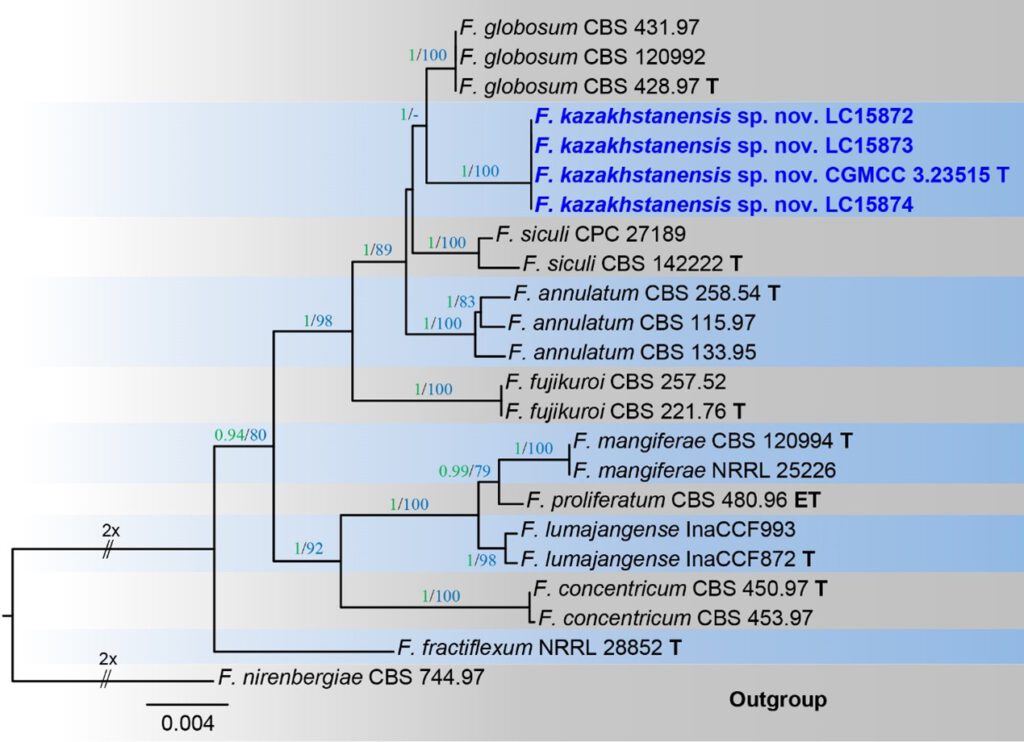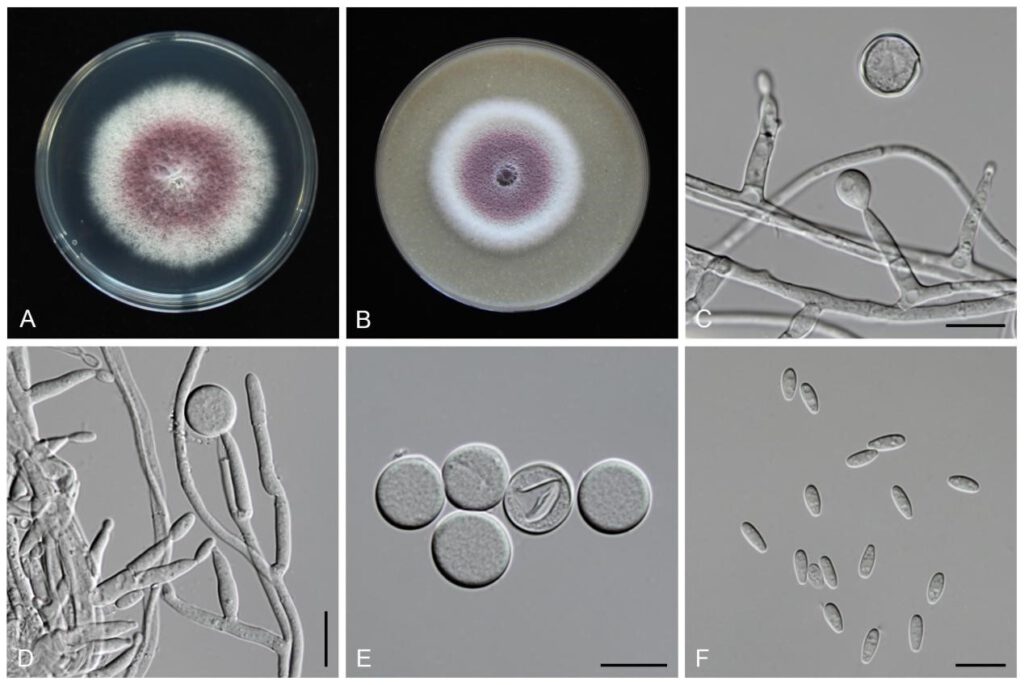Fusarium kazakhstanensis S.L. Han, M. Raza & L. Cai, sp. nov.
MycoBank number: MB 555883; Index Fungorum number: IF 555883; Facesoffungi number: FoF 10818; Fig. XX
Etymology: Refer to the type country, Kazakhstan.
Holotype: HMAS 351947
Description: Hyphae 1.7–3.5 μm diam, hyaline, smooth-walled, septate, branched. Conidiophores arises on aerial mycelium, unbranched or irregularly branched, 11–29.5 × 2–4.5μm (x̅ = 19.9 × 3.0 μm, n=35). Aerial phialides mono- and polyphialide, subulate to subcylindrical, smooth- and thin-walled, 4.8–17.4 × 1.6–3.9 μm, periclinal thickening inconspicuous or absent. Aerial conidia hyaline, smooth- and thin-walled, two types, clavate with truncate base conidia (aseptate): 4.5–9.5 × 1.5–3.5 μm (x̅ = 6.3 × 2.5 μm, n=50); globose conidia (aseptate): 6.5–11 × 7–11.5 μm (x̅ = 9.7 × 9.4 μm, n=50). Sporodochia and chlamydospores not observed.
Culture characteristics: Colonies on PDA slow growing, reaching 52–57 mm diam in 7 d after incubation at 25 °C in the dark, colony flat, medium, filamentous, felted to velvety, rhizoid; colony from above; raised, dull, wrinkled folded, surface orchid purple (14C8) in the center, white (–A1) at the margin; reverse beetroot purple (13D8) in the center, white (–A1) at the margin; odour absent, not producing pigment in PDA media. On OA reaching 41–49 mm in 7 d after incubation 25 °C in the dark; raised, felted to dusty, with abundant aerial mycelium, margin entire; surface amethyst (15C6) in the center, white (–A1) at the margin; reverse oak brown (5D6); odour absent.
Materials examined: KAZAKHSTAN, on wheat, 2019, W.Z. Li (HMAS 351947, holotype), ex-type living culture, CGMCC 3.23515 = LC15871. ibid., LC15872; ibid., LC15873; ibid., LC15874.
GenBank numbers: CaM = XXXXX, rpb1 = XXXXX, rpb2 = XXXXX, tef1 = XXXXX, tub2 = XXXXX.
Notes: Fusarium kazakhstanensis formed a well-supported sister clade to F. globosum with 100% ML and 1.00 Bayesian posterior probabilities (BPP) support (Fig. XXX). Fusarium kazakhstanensis differs by 3bp in the CaM gene, 16bp in the rpb2 gene, 6bp in the tef1 gene, and 1bp in the tub2 gene compared to F. globosum (Proctor et al. 2013; Yilmaz et al. 2021). Morphologically, F. kazakhstanensis differs in the types of microconida production and its number of septation. For example, F. kazakhstanensis produces two types of microconidia: clavate with a truncate base (aseptate) and globose (aseptate) without papilla, while three types of microconidia were observed in F. globosum: clavate with a truncate base (0- to 3-septate), napiform/pyriform, and globose (0- to 1-septate) which often have a distinct papilla (Rheeder et al. 1996; Leslie & Summerell. 2006).

Fig XXX. RAxML phylogenetic tree generated from combined CaM, rpb1, rpb2, tef1 and tub2 sequence data of Fusarium fujikuroi species complex. Maximum likelihood bootstrap support values greater than 75% (in blue) and Bayesian posterior probabilities >0.95 (in green) are indicated on the branches. Ex-type and epi-type cultures are indicated in bold with ‘T’ and ‘ET’

Fig XXX. Fusarium kazakhstanensis (CGMCC 3.23515, ex-type culture). a Colony on PDA. b Colony on OA. c-d Aerial conidiophores and phialides. e-f Microconidia. Scale bars = 10 μm.
